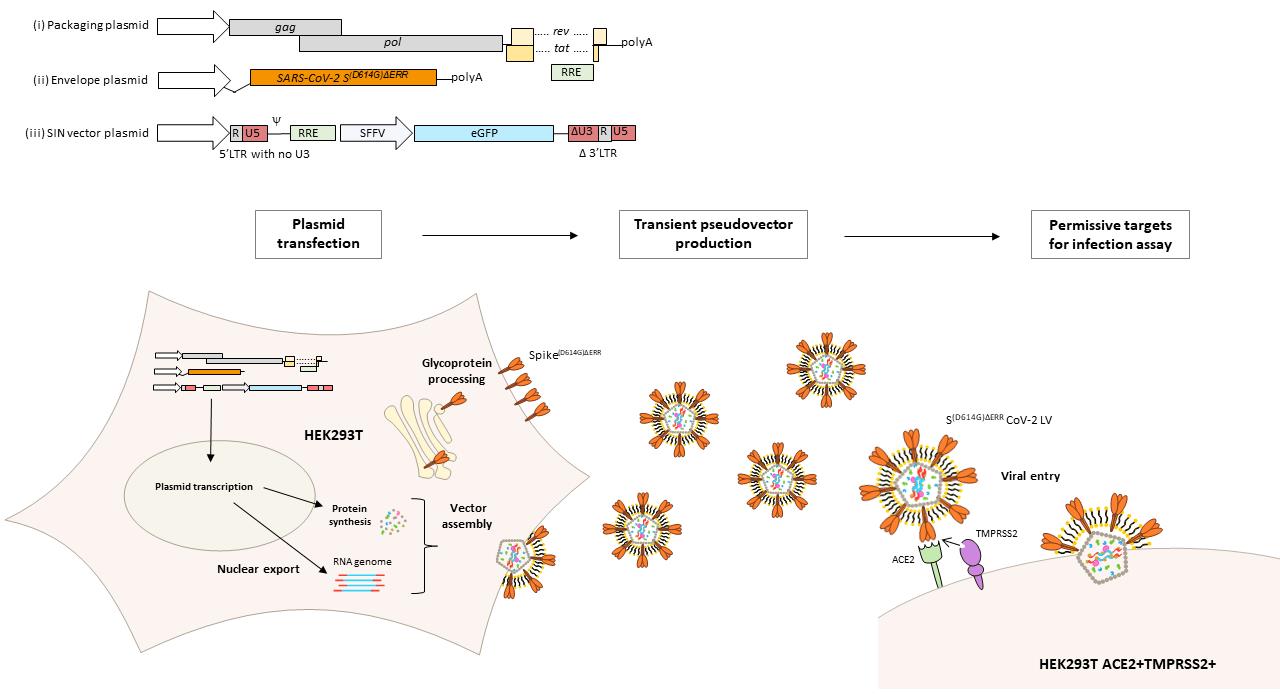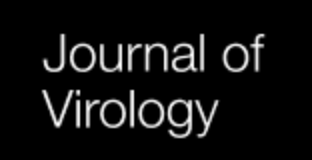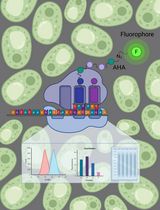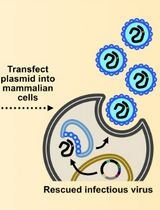- EN - English
- CN - 中文
Optimised Method for the Production and Titration of Lentiviral Vectors Pseudotyped with the SARS-CoV-2 Spike
SARS-CoV-2刺突慢病毒伪型载体制备和滴定的优化方法
发布: 2021年08月20日第11卷第16期 DOI: 10.21769/BioProtoc.4194 浏览次数: 4239
评审: George William CarnellRan ChenShyam Solanki
Abstract
The use of recombinant lentivirus pseudotyped with the coronavirus Spike protein of SARS-CoV-2 would circumvent the requirement of biosafety-level 3 (BSL-3) containment facilities for the handling of SARS-CoV-2 viruses. Herein, we describe a fast and reliable protocol for the transient production of lentiviruses pseudotyped with SARS-CoV-2 Spike (CoV-2 S) proteins and green fluorescent protein (GFP) reporters. The virus titer is determined by the GFP reporter (fluorescent) expression with a flow cytometer. High titers (>1.00 E+06 infectious units/ml) are produced using codon-optimized CoV-2 S, harbouring the prevalent D614G mutation and lacking its ER retention signal. Enhanced and consistent cell entry is achieved by using permissive HEK293T/17 cells that were genetically engineered to stably express the SARS-CoV-2 human receptor ACE2 along with the cell surface protease TMPRSS2 required for efficient fusion. For the widespread use of this protocol, its reagents have been made publicly available.
Graphic abstract:

Production and quantification of lentiviral vectors pseudotyped with the SARS-CoV-2 Spike glycoprotein
Background
Studies on SARS-CoV-2 viruses are hampered by the difficulty to produce and manipulate the live viruses that require biosafety level 3 (BSL-3) labs. An alternative to using live virus is to use recombinant lentivirus pseudotyped with the SARS-CoV-2 Spike protein. Pseudotyped viral vectors are very powerful tools for studying biological processes related to enveloped viruses, such as viral entry and immunological response. Pseudotyped viral particles consist of the envelope glycoprotein of one virus with a replication-deficient core of another virus. This allows the deficient core to be dependent on the pseudotyping envelope for target cell entry, thus allowing the investigation of SARS-CoV-2 infection and related serological responses.
Spike is a type-I fusion transmembrane protein expressed on the surface of viral particles as a crown-shaped trimer of heterodimers. In host cells, precursor glycoproteins are proteolytically cleaved by furin at the multibasic S1/S2 site, resulting in dimers composed of an extracellular subunit (S1) containing the receptor-binding domain, which is non-covalently attached to a transmembrane subunit (S2) responsible for viral fusion and subsequent cell entry (Hoffmann et al., 2020a; Peacock et al., 2020). Spike is both necessary and sufficient to induce membrane fusion and cell entry by first binding to its human receptor, ACE2 (hACE2), followed by its proteolytic cleavage by target cell proteases such as the transmembrane protease serine 2 (TMPRSS2) (Hoffmann et al., 2020b; Walls et al., 2020). Thus, Spike has been shown to be the primary target for neutralizing antibodies in COVID-19 convalescent patient sera (Chen et al., 2020; Ju et al., 2020; Pinto et al., 2020).
Spike from different coronaviruses have been successfully pseudotyped on different non-replication competent viruses (Carnell et al., 2017; Grehan et al., 2015; Yan et al., 2007; Fukushi et al., 2005). Accordingly, different viral vectors have been pseudotyped with Spike from SARS-CoV-2, including VSV (Letko et al., 2020; Nie et al., 2020), HIV (Ou et al., 2020; Wu, 2020), and MLV (Pinto et al., 2020; Quinlan et al., 2020) based vectors for neutralization assays, which have been reported to correlate with the live strain. However, a detailed protocol of pseudovector production has not been described for widespread application.
Herein, we describe a fast and reliable protocol for the production of a self-inactivating lentiviral vector pseudotyped with SARS-CoV-2’s Spike glycoprotein and expressing enhanced green fluorescent protein (eGFP) as a marker of infection, which has recently been used to determine neutralisation efficiency of COVID-19 therapeutics on four SARS-CoV-2 variants (Ferrari et al., 2021). The protocol employs a three-plasmid transfection in HEK293T/17 cells with the following plasmids: (i) plasmid expressing the HIV-1 lentiviral genes gag, pol, rev, and tat: (ii) a self-inactivating transfer vector encoding eGFP under an internal viral promoter derived from the spleen focus-forming virus (SFFV); and (iii) a plasmid encoding codon-optimized Spike, with or without the prevalent D614G mutation (Korber et al., 2020), under the cytomegalovirus (CMV) promoter with its ER retention signal (amino acid residues 1255 to 1273) deleted as it has been shown to enhance surface expression (Ou et al., 2020). Produced vectors are then quantified by an infectivity assay on genetically engineered HEK293T/17 cells that stably express hACE2 and TMPRSS2 (Supplementary Figure 1). This protocol has been recently used to produce lentiviral vectors pseudotyped with different SARS-CoV-2's Spike variants. These cells have been deposited in the repository of the National Institute for Biological Standards and Control’s Covid-19-related research reagents (CFAR #101008) for widespread use.
Materials and Reagents
Filtered Pipette tips 1-10, 1-20, 1-200, 100-1,000 μl (Starlab, catalog numbers: S1120-3810 [P10]; S1120-1810 [P20]; S1120-8810 [P200]; S1122-1830 [P1000]) or equivalent
10 cm plates (tissue-culture treated 100 mm dish; Corning, catalog number: 430167) or equivalent
24-well plates (TC-treated 24-well plate; Corning® Costar®, catalog number: 3527) or equivalent
Microcentrifuge tube with screw caps write-on graduated with lid latch 1.5 ml
15 ml conical centrifuge tubes (Merck, Corning®, catalog number: CLS430791) or equivalent
NuncTM EasYFlaskTM 75 cm2 cell culture flasks (ThermoFisher, catalog number: 156472) or equivalent
Sterile syringes (20 ml), generic
Millex-HV syringe filter unit, 0.45 µm, PVDF, 33 mm, gamma sterilized (Merck, catalog number: SLHV033RB) or equivalent
96-well V-bottom plate (96 Well TC-treated microplates, Corning, catalog number: 3894) or equivalent
Dry ice
Ethanol absolute ≥99.8% (Avantor, VWR Chemicals, catalog number: 20821.467DP) or equivalent
HEK 293T/17 cells (ATCC, catalog number: CRL-11268).
Engineered HEK 293T/17 cells with human ACE2 and TMPRSS2 (NIBSC code CFAR#101008)
Plasmids:
Transfer vector: pCCL.SFFV.eGFP
Lentiviral transfer vector encoding eGFP downstream of an SFFV promoter in a pCCL backbone.
Second-generation lentiviral packaging plasmid: pCMVR8.74 (Addgene, catalog number: 22036)
Glycoprotein expression plasmid: pCDNA-SARS-CoV-2-S(D614G)ΔERR
SARS-CoV-2 Spike glycoprotein downstream a CMV promoter in a pCDNA backbone. The glycoprotein contains the D614G substitution and deletion of the last 19 amino acids on its carboxyl-terminus to remove its ER retention signal (ΔERR).
Iscove’s Modified Dulbecco’s Medium (Merck, Sigma-Aldrich, catalog number: I3390) supplemented with 2mM L-glutamine and 10% fetal bovine serum (FBS) (Biosera, catalog number: FB-1001/500)
Puromycin (InvivoGen, catalog number: ant-pr-1) or equivalent
Reduced Serum media Opti-MEMTM (Thermo Fisher Scientific, GibcoTM catalog number: 31985047)
GeneJuice® Transfection Reagent (Merck Millipore, catalog number: 70967)
Phosphate-buffered saline (PBS) (Sigma, catalog number: D8537) or equivalent
Cell dissociation buffer Enzyme-free PBS-based (Thermo Fisher Scientific, GibcoTM catalog number: 13151014) to avoid surface cleavage of both hACE2 and TMPRSS2
Polybrene transfection reagent 10 mg/ml (Merk, catalog number: TR-1003-G)
Viability dye (Thermo Fisher Scientific, eBioscienceTM Fixable Viability Dye eFluorTM 780, catalog number: 65086514) or equivalent
Equipment
Class II biosafety cabinet (Thermo Fisher Scientific, Thermo ScientificTM, model: HeraSafeTM 2030i)
Water bath (Avantor, VWB2 series, VWB2 2, catalog number: 462-0554) or equivalent
Incubator (Eppendorf, model: CellXpert® C170) or equivalent
Pipettes (Eppendorf Research® plus, P2, P20, P200, and P1000) or equivalent
Cell counter (Chemometec, Automated cell Analyzer NucleoCounter® NC-250TM) with Solution 18 AO.DAPI (Chemometec, catalog number: 910-3018) or equivalent
Plate centrifuge (Thermo Fisher Scientific, model: Heraeus Multifuge X3R) or equivalent
Flow cytometer equipped with a blue and red laser
This protocol utilized a BD LSRFortessaTM X-20 cell analyser but is not restricted to this equipment. In the absence of a flow cytometer, a fluorescent microscope fitted with a 488 nm excitation laser can be used.
Software
FlowJoTM Software, version 10.7.1 (BD Bioscience)
An alternative software for Flow Cytometry analysis can be used.
Procedure
文章信息
版权信息
© 2021 The Authors; exclusive licensee Bio-protocol LLC.
如何引用
Mekkaoui, L., Bentley, E., Ferrari, M., Lamb, K., Ward, K., Karattil, R., Akbar, Z., Bughda, R., Sillibourne, J., Onuoha, S., Mattiuzzo, G., Takeuchi, Y. and Pule, M. (2021). Optimised Method for the Production and Titration of Lentiviral Vectors Pseudotyped with the SARS-CoV-2 Spike. Bio-protocol 11(16): e4194. DOI: 10.21769/BioProtoc.4194.
分类
分子生物学 > 蛋白质 > 检测
微生物学 > 微生物-宿主相互作用 > 病毒
生物化学 > 蛋白质 > 合成
您对这篇实验方法有问题吗?
在此处发布您的问题,我们将邀请本文作者来回答。同时,我们会将您的问题发布到Bio-protocol Exchange,以便寻求社区成员的帮助。
提问指南
+ 问题描述
写下详细的问题描述,包括所有有助于他人回答您问题的信息(例如实验过程、条件和相关图像等)。
Share
Bluesky
X
Copy link












